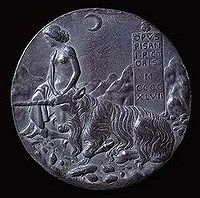
PREV ARTICLE
NEXT ARTICLE
FULL ISSUE
PREV FULL ISSUE
IMPRESA: THE FIRST TRADEMARKS APPEARED ON MEDALS Dick Johnson submitted this interesting item about the original of trademarks, which first came into popular use on Renaissance medals. -Editor  Last week I pleaded for the replacement of ANA's existing logo. The history of logos and trademarks -- the two words mean about the same save for the legal protection which can be obtained for a trademark -- can be traced back to Renaissance medals. Surprise! Even early medals were important for more than just portraits of Renaissance celebrities. Last week I pleaded for the replacement of ANA's existing logo. The history of logos and trademarks -- the two words mean about the same save for the legal protection which can be obtained for a trademark -- can be traced back to Renaissance medals. Surprise! Even early medals were important for more than just portraits of Renaissance celebrities. Scholars credit the invention of the trademark to the inventor of the Renaissance medal -- Pisanello (whose real name was Antonio Pisano, 1397?-1453). Pisanello placed small symbols on his cast medals. However the first of these subsidiary symbols appearing on medals were intended to be somewhat obscure. You really had to know the person to recognize the trait that Pisanello recorded as a symbol adjacent to that person's portrait. Today's logos, trademarks and seals are just the opposite of obscure. They are intended to be recognized as the symbol of their sponsor. We are all exposed to trademarks, perhaps 800 different a day. An average adult can recognize about 1200 different, about half of which can be tied to their intended sponsor. Why so many? Because every entity, every corporation, institution, organization -- every group it seems -- has a trademark or logo. The U.S. government in 1790 established an agency (along with patents) to register these for legally protecting these symbols. Currently these are identified by a T in a tiny circle like a degree mark you see after the word or symbol. Pisanello's invention of his identifying symbol is called impresa. The word is pronounced like you would suspect, em-press-a with a short a. The plural is imprese (pronounced em-prez). The best discussion (and definition) of impresa was given by Lottie Salton in the catalog introduction of her family's collection on loan at Bowdoin College, Baldwin, Maine. The Salton Collection: Renaissance and Baroque Medals and Plaquettes (published 1965, revised 1969). She identified the impresa for precisely what it was -- a logo of the person portrayed. In later centuries, the impresa became more formalized, sometimes heraldic (often with a slogan on a banner), and, in contrast to Pisanello's creations, became more symbolic of the person or group they symbolized. And less obscure! Numerous books on trademarks and seals I have studied give credit to Pisanello as the originator of trademarks based on his impresa. Some just mention impresa as the first ever logos. Today designing a new seal, logo or trademark requires extensive expertise. Some agencies can devote years and hundreds of thousands of dollars of research to create a new logo, for say, a Fortune 500 corporation. To them, it's worth millions! Thus, the American Numismatic Association should not treat this project lightly. And should give knowledgeable, considered attention to its new symbol. To be created by a medallist! For more information, see the Wikipedia entry on Antonio Pisano: Pisanello (http://en.wikipedia.org/wiki/Pisanello) Wayne Homren, Editor The Numismatic Bibliomania Society is a non-profit organization promoting numismatic literature. See our web site at coinbooks.org. To submit items for publication in The E-Sylum, write to the Editor at this address: whomren@gmail.com To subscribe go to: https://my.binhost.com/lists/listinfo/esylum All Rights Reserved. NBS Home Page Contact the NBS webmaster 
|